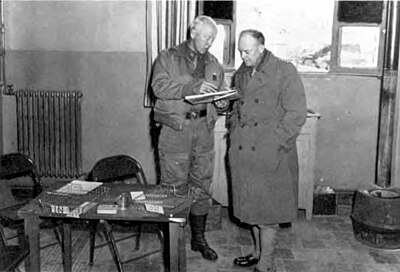
General Patton (left) confers with General Eisenhower at the beginning of the II Corps offensive. (DA photograph)
commander who would cause his adversaries genuine concern for his willingness to attempt maneuvers others thought rash. With Maj. Gen. Omar N. Bradley as his deputy, Patton set about rebuilding the II Corps into the panzer-killing force he knew it could become. Overlooking no detail—including neckties in the heat of North Africa—Patton pushed his men to fight and dress like the best soldiers in the world. Within days they knew they were led by a commander who would not let them fail.
But these preparations did not take place with Axis cooperation. Kesselring kept up the pressure, this time in the north. On 26 February von Arnim launched an offensive against the British in an effort to push his front west to give the Axis a wider secure zone around Tunis. This offensive, which Rommel labeled the brainchild of "nincompoops," failed but served as a painful reminder that Axis units were capable of much hard fighting. Paired with the Axis northern thrust was another in the south. In his last battle in Tunisia, Rommel on 6 March struck the British Eighth Army at Medenine soon after its arrival from Libya. The British blunted the attack and in doing so may have found the tactic that could stop the panzers: massed artillery and antitank fire combined with air raids.
19
